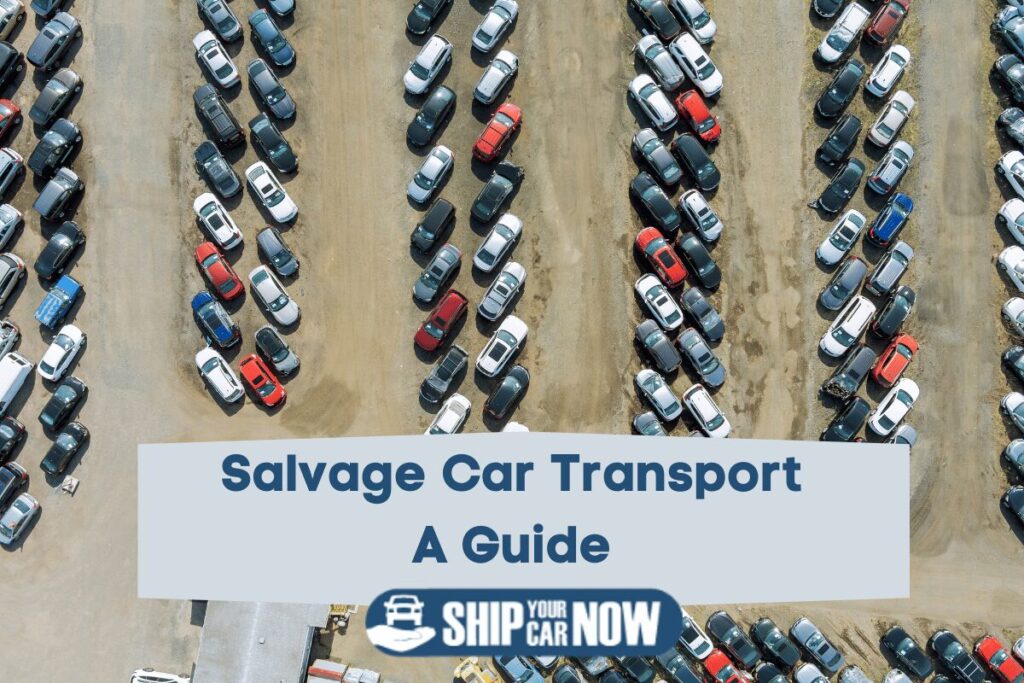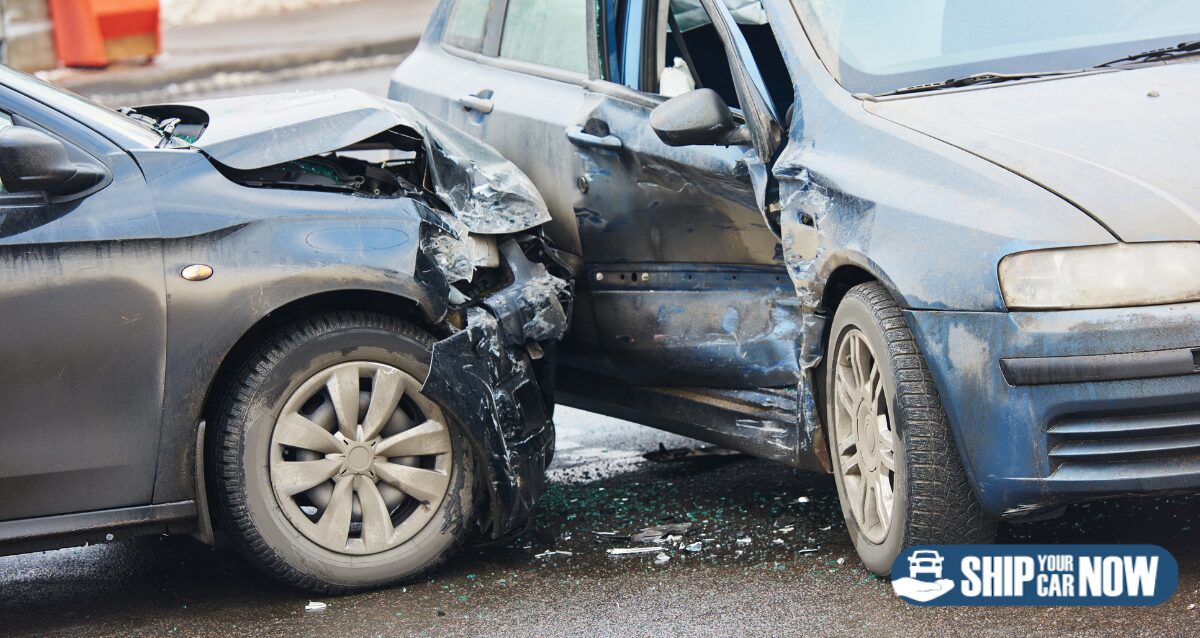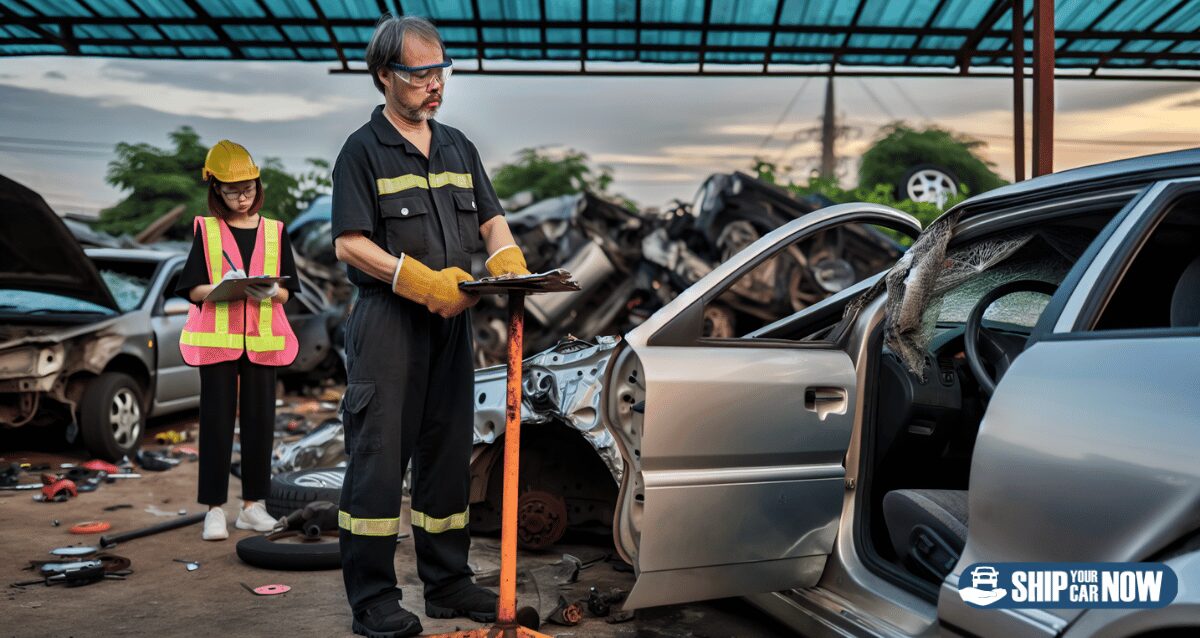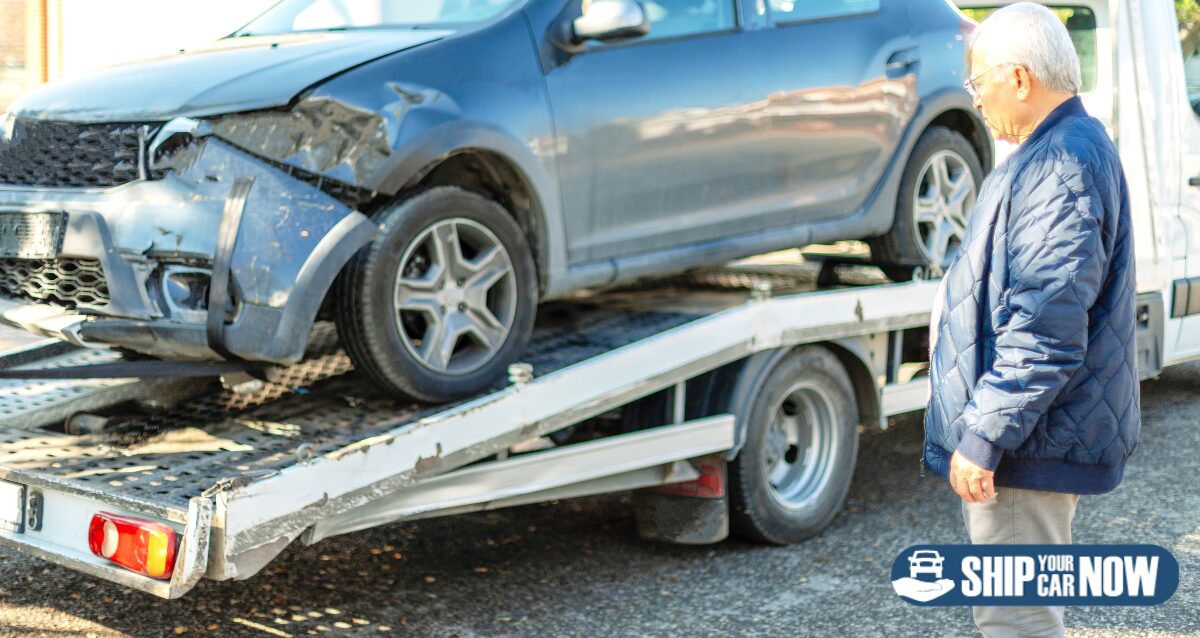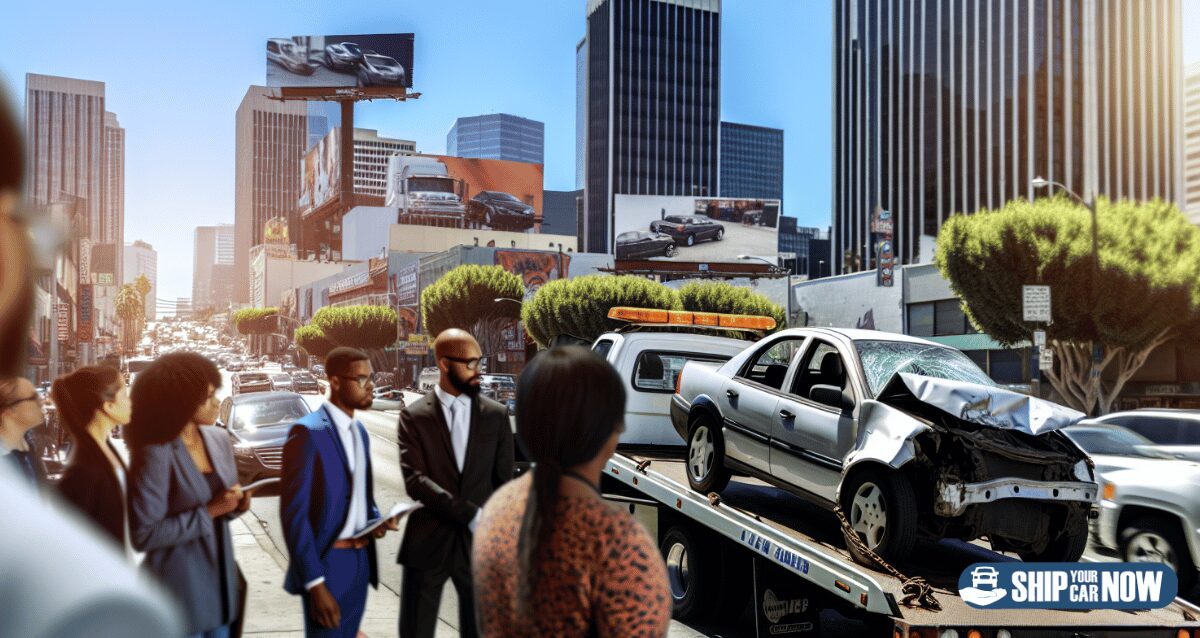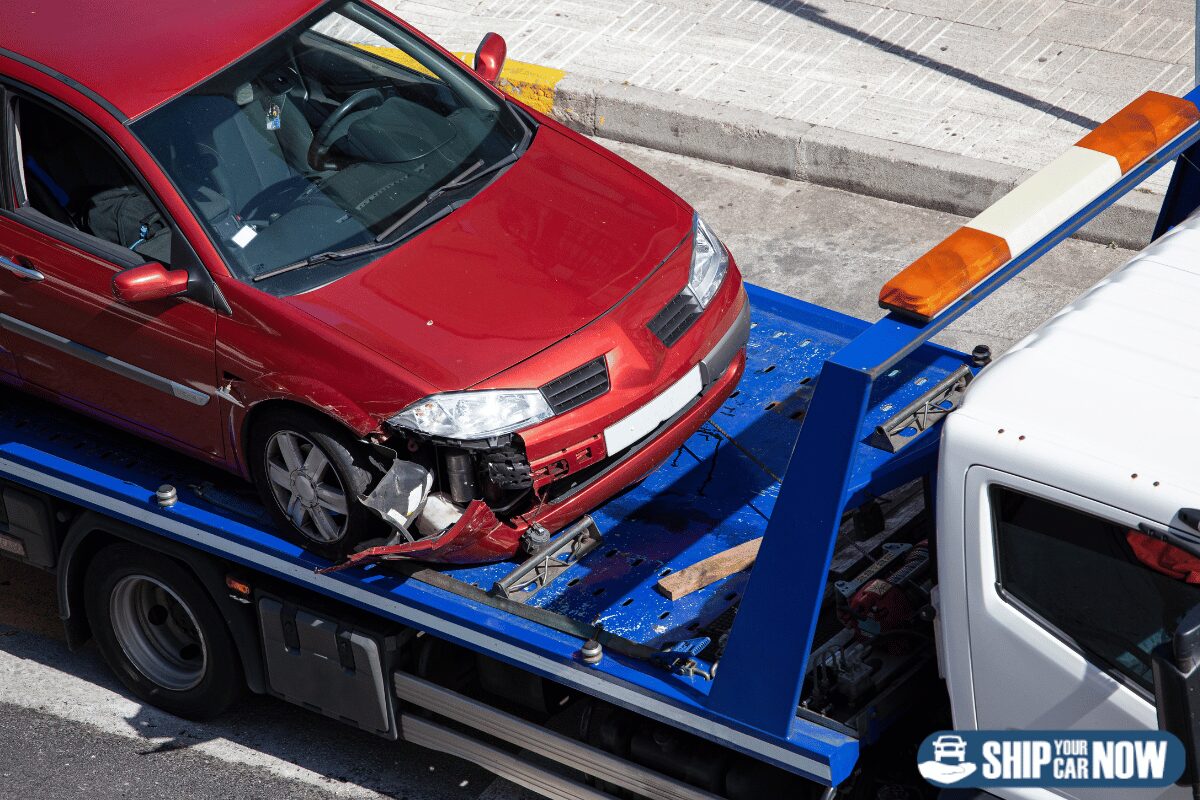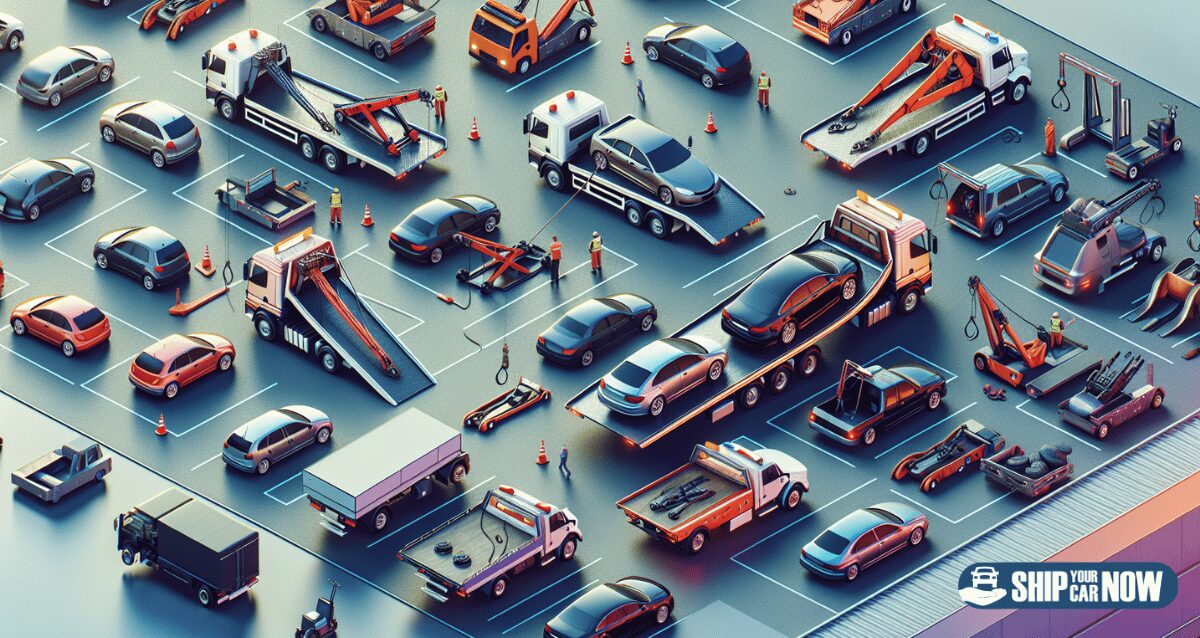One man’s trash is another man’s treasure. Car salvage is a lucrative industry and is an essential part of the car ecosystem. If you’re stumped on how to transport a salvage car, you’re not alone. With unique handling requirements and potential hidden costs, salvage car transport demands careful planning and specialized services.
Let’s get some perspective on the process of transporting a salvage car. Below you’ll find some clear guidance—from choosing a professional car transportation service to understanding the pricing and timelines involved—equipping you with the knowledge to tackle this specialized transport task confidently.
Salvage car transport doesn’t have to be difficult or complicated, it’s as easy as finding the right car shipping company to work with.
Key Takeaways
- Salvage car transport refers to the specialized process of moving damaged or totaled vehicles and requires the use of equipment like forklifts or flatbed trucks, as well as careful preparation and securing of the vehicle to prevent further damage.
- The cost to transport a salvage car can range from $0.50 to $1.50 per mile, with the total cost influenced by factors such as distance, route complexity, vehicle condition, size, and the need for special handling or equipment.
- Choosing the right auto transport company is crucial when shipping salvage vehicles; it should be reputable, experienced in dealing with such cars, properly insured, and offer secure payment options, as exemplified by ShipYourCarNow.
Understanding Salvage Car Transport
So, what exactly does the term “salvage car transport” mean? Simply put, it is the process of moving damaged, wrecked, or vehicles that have been declared a total loss, also known as salvaged vehicle transport. These vehicles are not suitable for road use and must be moved to locations for:
- Storage
- Auction
- Repair
- Parts Dismantling
Salvage car transport is best handled by professionals with specialized skills. There are so many little nuanced elements to shipping a salvage car. Including the equipment.
The transportation of salvage cars, which are often inoperable, requires the use of a forklift or flatbed truck, along with equipment such as winches.
This specialized handling and use of equipment is crucial for avoiding further damage and ensuring the safe transportation of these vehicles.
The Salvage Car Shipping Process
Shipping a salvage vehicle is a detailed process that requires careful planning and execution. From deciding on the type of carrier to providing detailed pickup information and communicating the car’s salvage status and condition to the auto transport company, every step plays a crucial role in ensuring a smooth and successful salvage car shipment.
Step 1: Preparing The Salvage Vehicle for Transport
Prior to shipping a salvage vehicle, it is imperative to conduct a thorough assessment of the vehicle’s damage. This not only helps in determining special loading requirements but also identifies loose parts that may need securing. Even though the car is likely already very damaged, it’s important to have a full detailed summary of its condition.
Take pictures, make notes, get signatures. Keep everything on your phone and ready for when you need it.
Loose items are the toughest part of salvage car transport. Loose car parts should be either secured inside the damaged vehicle or reattached to prevent movement that could cause additional damage or become lost during transport.
Another key step in preparing your salvage vehicle for transport is ensuring the availability of the car’s keys. Given the value and complexity of replacing modern vehicle keys, this can help avoid shipping delays.
Here is a checklist of some of the most important things to consider during salvage car transport.
- Take pictures of the car
- Locate the keys
- Secure loose parts
- Check fluid levels
- Disable alarms
- Ensure the battery is charged (if possible)
- Avoid packing the car with too many personal items (or simply remove all)
Following these steps will help ensure a smooth and efficient transport process. That’s the kind you will ultimately prefer.
Step 2: Loading and Securing Salvaged Cars
Sure we all have a few tools in the garage or shed, but most of us don’t have a forklift handy and ready for use. Loading and securing salvage cars is a specialized task that requires appropriate equipment and skills.
Tow trucks, forklifts, and flatbed trucks are essential for transporting these damaged vehicles.
Once the salvage vehicles are loaded, they are typically secured on open transport carriers due to cost-effectiveness, with the option of enclosed transport for additional protection.
If you’ve ever tried to move a salvage car, you’ll understand just how difficult this can be and how easy it is to avoid. Let the pros take this one.
Step 3: Transportation and Delivery of Damaged Vehicles
Once the salvage car is loaded and secured, the transportation process begins. However, it’s important to note that delays can occur due to seasonal weather, traffic congestion, or unexpected route changes.
To accommodate unforeseen delays, we recommend adding some cushion time to the shipping schedule. Consider adding a day or two to any delivery expectations, especially those that are across state lines.
Step 4: Inspect, Inspect, Inspect
On delivery, it is vital to immediately inspect the salvage vehicle for any new discrepancies or damages and notify the transporter. This is where that detailed report and pictures you took earlier will come in handy. Of course, this is a salvage car, so the need to monitor damage may seem ridiculous.
That being said, we believe it’s always best to be safe than sorry. It’s better to have the images of the car before shipping, even if you don’t need them.
Costs Involved in Salvage Car Transport
Transporting a salvaged car is generally more expensive than transporting a typical vehicle due to the need for special carriers and the complexity involved in handling these salvaged cars.
The estimated cost for transporting a salvage car may range from $0.50 to $1.50 per mile, and the total cost can be anywhere between $500 to $1,200 or more, varying with transport type and distance.
We will now delve into these cost-influencing factors in greater depth.
Distance and Route
The distance between the pickup and delivery locations is the primary determinant of car shipping costs. Longer distances result in higher costs due to increased fuel consumption, driver hours, and wear on carriers.
Transporting a salvage car over longer distances requires more extensive planning and logistics, influencing the overall cost structure for such transport.
The complexity of the route can also have a significant impact on shipping costs. Some factors to consider include:
- Navigating through congested urban areas
- Dealing with road tolls
- Detours around traffic or road works
- Geographic challenges, such as mountainous regions or the need to cross over bodies of water
These factors can add to the cost of shipping due to extra time and fuel requirements.
Vehicle Condition and Complexity
The condition and size of the vehicle can also impact shipping costs. Non-operational vehicles generally require special equipment or handling, leading to higher shipping costs compared to operational vehicles.
Larger and heavier vehicles incur higher shipping costs due to the need for more space on transport carriers and specialized equipment for safe loading and unloading.
Furthermore, specialty vehicles, like luxury or classic cars, may require more protective measures during transport, such as enclosed carriers, which can increase the shipping cost. Understanding these factors can help you better predict the cost of shipping a salvage car and plan your budget accordingly.
Choosing the Right Auto Transport Company
Selecting the appropriate auto transport company is an essential step in the process of shipping salvage cars. You should opt for a reputable service with positive customer reviews and an A+ rating from the Better Business Bureau, guaranteeing their commitment to customer satisfaction.
It’s also important to choose auto transport companies experienced in shipping salvage cars, ensuring they are equipped to handle specific requirements like securing loose parts and employing drivers with specialized skills.
In addition, confirm that the transport company is bonded, insured, and registered with the Department of Transport. This ensures that they provide safe and professional services, including appropriate carriers and drivers, as well as an inspection report at both pickup and delivery.
Lastly, select a company that fits your needs and budget, providing a variety of secure payment options.
Salvage Car Auctions: What to Expect
Salvage car auctions offer a unique opportunity to purchase a variety of vehicles at significant discounts, sometimes reaching 70-80% of market value [1].
However, these auctions are generally open to licensed dealers or individuals working with brokers. Technological advancements have made navigating auctions easier, with mobile apps and websites allowing participants to access a wider selection of salvage vehicles.
Nonetheless, one must balance potential benefits against risks, such as underlying vehicle damage, and be well-informed about auction-specific protocols to sidestep unforeseen costs.
When purchasing a salvage vehicle from an auction, coordinating with a transport company for pickup and settling all financial obligations before arranging transport can help avoid delays and additional fees.
Legal Considerations for Shipping Salvage Title Cars
When it comes to shipping salvage title cars, there are certain legal considerations to keep in mind. Here are some important points to remember:
- Proper documentation, such as the salvage title and registration, is required.
- The original certificate of title or a certified copy must be presented to Customs for exportation.
- If the car being exported is leased or has a lien, additional authorization from the interested third party is required.
Documentation for export must be presented to Customs at specific times and locations, with all documents verified for authenticity. Also, the transport of salvage cars must adhere to laws regarding permits, hazardous materials, and the transporter’s responsibility for verifying vehicle status and ownership.
Finally, insurance coverage for salvage vehicles should consider the risks during transit.
It is also essential to comprehend the shipping company’s comprehensive insurance coverage terms to guarantee sufficient liability coverage from an insurance company.
Specialized Equipment for Salvage Vehicle Transport
Transporting salvage vehicles requires the use of specialized equipment. Some options for transporting these vehicles include:
- Flatbed carriers: These are ideal for transporting inoperable and damaged cars, as they have a flat-level bed.
- Tow trucks: These are commonly used for towing vehicles that are not in running condition.
- Enclosed trailers: These provide protection for valuable or delicate salvage vehicles during transport.
- Rollback carriers: These have a hydraulic bed that can be tilted to load and unload vehicles.
Each of these options has its own advantages and is suitable for different types of salvage vehicles.
For loading and unloading, equipment like winches and flatbed trucks are often employed, particularly with inoperable salvage cars.
Safety is paramount during transport, and equipment like straps and winches are utilized to properly secure the vehicles on the carrier. Depending on the value and condition of the salvage vehicle, enclosed carriers may be chosen over open carriers to offer additional protection from environmental hazards.
Tips for a Smooth Salvage Car Shipping Experience
Having gained a comprehensive understanding of the salvage car shipping process, let’s consider some tips to facilitate a seamless transport experience.
- Effective communication with the transport company is vital, helping avoid misunderstandings and ensuring proper vehicle handling.
- Before shipping, thoroughly document existing vehicle damage with photos, providing clear evidence for any claims regarding new damages incurred during shipping.
- Upon delivery, conduct a detailed inspection and test drive the salvage car to confirm that everything is functioning as expected and that no new damages have occurred during transport.
These best practices will not only help ensure a successful transport experience but also provide peace of mind throughout the entire shipping process itself.
ShipYourCarNow: Your Trusted Solution for Reliable and Affordable Auto Transport Services
ShipYourCarNow distinguishes itself by providing safe and reliable transport, and affordable auto transport services. We offer a full range of car transport services, catering to both businesses and individuals alike.
We provide door-to-door shipping, and our services are available coast-to-coast (domestic US) and internationally.
Our expert logistics agents are standing by 24/7 to help with your car transport needs. Moreover, all our car shipping services comes with Claim Assistance, meaning in the event of any damage, we will help you through the process. Choosing a trusted service like ShipYourCarNow can certainly make the daunting task of shipping a salvage car much more manageable.
Full Summary
Transporting salvage cars involves a complex process that requires specialized handling and equipment.
From understanding what salvage car transport entails to preparing your vehicle for transport, choosing the right auto transport and car shipping company beforehand, and navigating legal considerations, this comprehensive guide has covered each step in detail.
With careful planning, efficient communication, and the right service provider like ShipYourCarNow, you can ensure a smooth and successful salvage car transport experience.
Frequently Asked Questions
Are salvage cars OK?
While some salvage cars can be repaired to a “like new” condition, safety can be a concern due to the extent of the damage and the quality of repair work. It’s important to be cautious, especially with flood-damaged vehicles.
Can you ship a salvage title car to Puerto Rico?
No, you cannot ship a salvage title car to Puerto Rico unless the vehicle is in working condition and can be driven onto the vessel [2].
Can you drive a salvage vehicle in North Carolina?
No, you cannot drive a salvage vehicle in North Carolina until it is repaired and passes a salvage vehicle inspection [3].
Can you drive a salvage car in Washington state?
No, a salvage car cannot be driven in Washington state until it has been rebuilt, inspected, and issued a new title. Drive carefully!
Can you drive a salvage car in SC?
No, salvage cars with titles branded “only for parts” cannot be driven on South Carolina roads or in most other states.
Senior automotive logistics professional with a passion for the industry and a 10+ year history of accomplishments. Proven track record of exemplary client management working with both RMCs, Van Lines and OEMs. Keen ability to react to an ever-changing marketplace while offering superior technology solutions, programs and services. Architect of award winning auto transport portal technology offering transparency and agility to clients, agents and transferees. Successful team builder and leader easily managing budgets with effective leadership, strategic planning, and problem-solving capabilities.

